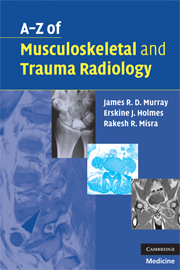Book contents
- Frontmatter
- Contents
- Acknowledgements
- Preface
- List of abbreviations
- Section I Musculoskeletal radiology
- Section II Trauma radiology
- ATLS – Advanced Trauma Life Support
- Acetabular fractures
- Aortic rupture
- Cervical spine injury
- Flail chest
- Haemothorax
- Open fractures
- Pelvic fracture
- Peri-physeal injury
- Pneumothorax
- Rib/sternal fracture
- Skull fracture
- Thoraco-lumbar spine fractures
- Acromioclavicular joint injury
- Carpal dislocation and instability
- Clavicular fractures
- Elbow injuries and distal humeral fractures
- Hand injuries – general principles
- Hand injuries – specific examples
- Thumb metacarpal fractures
- Humerus fracture – proximal fractures
- Humerus fracture – shaft fractures
- Humerus fracture – supracondylar fractures – paediatric
- Radius fracture – head of radius fractures
- Radius fracture – shaft fractures
- Galeazzi fracture dislocation
- Radius fracture – distal radial fractures
- Related wrist fractures
- Scaphoid fracture
- Scapular fracture
- Shoulder dislocation
- Ulna fracture – proximal and olecranon fractures
- Ulna fracture – shaft fractures
- Monteggia fracture dislocation
- Accessory ossicles of the foot
- Ankle fractures
- Bone bruising
- Calcaneal (Os calcis) fractures
- Femoral neck fracture
- Femoral shaft fracture
- Femoral supracondylar fracture
- Hip dislocation – traumatic
- Knee soft-tissue injury
- Metatarsal fractures – commonly fifth MT base
- Patella fracture
- Tibial-plateau fracture
- Tibial-shaft fractures
- Tibial-plafond (Pilon) fractures
- Talus fractures/dislocations
Hand injuries – general principles
from Section II - Trauma radiology
Published online by Cambridge University Press: 22 August 2009
- Frontmatter
- Contents
- Acknowledgements
- Preface
- List of abbreviations
- Section I Musculoskeletal radiology
- Section II Trauma radiology
- ATLS – Advanced Trauma Life Support
- Acetabular fractures
- Aortic rupture
- Cervical spine injury
- Flail chest
- Haemothorax
- Open fractures
- Pelvic fracture
- Peri-physeal injury
- Pneumothorax
- Rib/sternal fracture
- Skull fracture
- Thoraco-lumbar spine fractures
- Acromioclavicular joint injury
- Carpal dislocation and instability
- Clavicular fractures
- Elbow injuries and distal humeral fractures
- Hand injuries – general principles
- Hand injuries – specific examples
- Thumb metacarpal fractures
- Humerus fracture – proximal fractures
- Humerus fracture – shaft fractures
- Humerus fracture – supracondylar fractures – paediatric
- Radius fracture – head of radius fractures
- Radius fracture – shaft fractures
- Galeazzi fracture dislocation
- Radius fracture – distal radial fractures
- Related wrist fractures
- Scaphoid fracture
- Scapular fracture
- Shoulder dislocation
- Ulna fracture – proximal and olecranon fractures
- Ulna fracture – shaft fractures
- Monteggia fracture dislocation
- Accessory ossicles of the foot
- Ankle fractures
- Bone bruising
- Calcaneal (Os calcis) fractures
- Femoral neck fracture
- Femoral shaft fracture
- Femoral supracondylar fracture
- Hip dislocation – traumatic
- Knee soft-tissue injury
- Metatarsal fractures – commonly fifth MT base
- Patella fracture
- Tibial-plateau fracture
- Tibial-shaft fractures
- Tibial-plafond (Pilon) fractures
- Talus fractures/dislocations
Summary
Characteristics
Included in this group are phalangeal/metacarpal fractures, small-joint subluxation/dislocations and ligament injuries, tendon and nerve injuries.
Hand injuries are common, e.g. industrial/agricultural trauma, domestic DIY and kitchen-knife injuries, glass injuries, sporting trauma and the ubiquitous road trauma.
All ages are afflicted by hand injury.
Clinical features
Swelling, bruising, deformity, reduced range of movement, fracture crepitus and compartment syndrome are possible findings.
The clinical history and examination should separate soft tissue from bony pathology and also joint from bone injury.
Comparative examination (with contralateral side) particularly useful in one-side injuries, e.g. normal rotation, capillary refill and sensation.
Radiological features
AP and lateral view centred on the appropriate bone/joint with adjacent joint essential.
Look for fractures, including small avulsion fractures indicative of tendon, ligament or volar plate injury.
Look at alignment – assessing joint subluxation/dislocation – usually obvious on the lateral but look for bony overlap on the AP film.
Soft-tissue swelling can also be seen on radiograph.
Assess the articular surface carefully for fractures, depression and loose bodies.
Management
Assess soft tissues, neurovascular status and (after any reductions) immobilise initially.
Metacarpal block (‘ring block’) with local anaesthetic into the web space either side of the injured digit, gives good analgesia (up to 8 hours if bupivicaine used) for initial assessment and the emergency treatment of injury.
Dislocated joints and displaced fractures should be reduced, and stability assessed, and open fractures should be irrigated as soon as possible and a dressing applied.
Non-operative treatment for undisplaced fractures and stable joints after reduction of a dislocation.
Operative treatment for displaced or unstable fractures, intra-articular injury with a visible step, recurrent dislocations or subluxation, some missed injuries, e.g. mallet deformity presenting late.
[…]
- Type
- Chapter
- Information
- A-Z of Musculoskeletal and Trauma Radiology , pp. 234 - 236Publisher: Cambridge University PressPrint publication year: 2008



